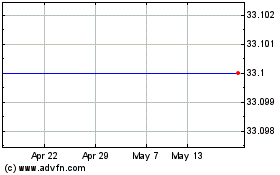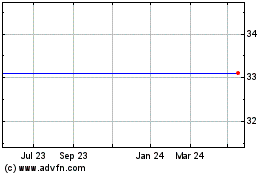The Group is largely naturally hedged at an operating level
because it buys a significant proportion of its raw materials in
Euros and Japanese Yen, operates its wafering factory within the
Euro zone and pays for the sub-contracting of wafer production in
Japan in Japanese Yen. However, the ingot manufacturing operation
is within the United Kingdom and therefore a relatively small
proportion of overall costs are in Sterling, being mainly related
to personnel costs, overheads and utilities (most of the raw
materials are purchased in Euros and Japanese Yen). In addition,
the Group has a relatively large debtor book in Japan denominated
in Japanese Yen and this is subjected to exchange rate fluctuation
of that currency. The Group has, to a certain extent, Japanese Yen
borrowings to hedge against downwards movement in the Japanese
Yen/Euro exchange rate. This process continues to be under
review.
After careful consideration and due to the Group's natural
operating hedging position coupled with its policy of matching
borrowings in Japanese Yen with Japanese Yen assets, the directors
have adopted a long-term policy of setting off any downside risks
of currency fluctuation against the associated upside risks.
During 2012 the Japanese Yen/Euro exchange rate decreased 13.26%
(2011: increased 7.24%). The impact of this increase on the profit
or loss was to decrease sales revenues by approximately 4.9% (2011:
increase 2.1%) and decrease the cost of materials and services by
approximately 1.4% (2011: increase 3.9%).
For each 1% increase in the Japanese Yen/Euro exchange rate
profits would decrease by approximately EUR298,000 (2011: decrease
by EUR677,000). The effect of the movement in the Japanese Yen/Euro
exchange rate on assets held in Japanese Yen has been considered.
Group management has arranged borrowings in Japanese Yen so that
these partially offset asset balances held in that currency.
Therefore, based on Japanese Yen asset balances on 31 December
2012, each 1% movement in the Japanese Yen/Euro exchange rate would
have an immaterial effect on the currency translation
adjustment.
During 2012 the net gain on foreign currency adjustments was
EUR2.4 million (2011: loss of EUR1.4 million). This gain was mainly
related to the conversion of currency balances in respect of Group
advances or loans, currency debtor/creditor balances, currency
advance payments to raw material suppliers and currency cash
balances. These can be broken down into the following broad
categories:
2012 2011
million million
---------------------------------------------------- -------- --------
Revaluation of cash balances 0.4 0.3
Revaluation of Group loans /intercompany account (0.5) (2.8)
Revaluation of Group raw material deposits (1.0) (0.4)
Accounts receivable / accounts payable revaluation 1.1 0.6
Revaluation of customer/suppliers deposits 0.3 3.7
Revaluation of balance sheet provisions 2.1 -
---------------------------------------------------- -------- --------
Total currency gain 2.4 1.4
---------------------------------------------------- -------- --------
In addition to the above, upon translation of net assets in the
consolidation, there was a negative impact in 2012 of EUR1.3
million (2011: positive EUR5.2 million) recording as a currency
translation adjustment which is shown in the consolidated statement
of comprehensive income as other comprehensive income.
Interest rate risk
The Group is exposed to interest rate fluctuation risks, since
the Group's loan agreements largely are subject to variable
interest rates. All variable interest rate loans are of a
short-term nature with a maturity of less than twelve months. The
borrowings of EUR5.3 million at the end of 2012 are in Japanese Yen
(2011: EUR49.0 million). Accordingly, there is a downside risk that
Japanese Yen interest rates may increase substantially from the
current relatively low levels. However, the Group has a regular
strong Japanese Yen income sufficient to repay the loans (if Group
management wished to do so) within a twelve month time scale.
On 31 December 2012 the Group borrowings in Japanese Yen were
EUR5.3 million (2011: EUR49.0 million) at an interest rate of
approximately 0.78% (2011: average rate 0.97%). For each 1% rise in
the Japanese Yen interest rates Group interest costs would increase
by approximately EUR53,000 (2011: EUR490,000). Accordingly, Group
profits and equity would fall or rise (after corporation tax in
Japan) by approximately EUR26,500 (2011: EUR245,000).
Further sensitivity analysis of the accruals and loans
outstanding at the year-end has not been disclosed as these are
virtually all current and paid in line with standard payment
terms.
The Group's borrowings in Japanese Yen are also current and have
no set repayment plan being secured on the Japanese receivables
book. The interest on this loan is paid monthly in arrears.
The Group had a significant net cash balance at the end of 2012
of EUR89.4 million (2011: EUR22.6 million) and places these cash
funds on deposit with various quality banks subject to a counter
party limit of EUR15 million. Accordingly, there is an interest
rate risk in respect of interest receivable which amounted to
EUR0.8 million in the year (2011: EUR0.9 million). Therefore, even
if average interest rates applicable to our cash deposits fell to
zero there would be limited effect on Group profits.
Liquidity risk
Liquidity risk is the risk that the Group will not be able to
meet its financial obligations as they fall due. The Group manages
its exposure to liquidity risk by regularly reviewing net debt and
forecast cash flows to ensure that current cash resources are
available to meet its business objectives. The Group is exposed to
the worldwide photovoltaic market and due to current overcapacity
this market has suffered large decreases in pricing over the
previous two years and market pricing of the group's main product
(silicon wafers) remain under pressure. Against this difficult
market background, Group management has put in place a Cash
Conservation Plan, which involved putting in place various measures
so that the Group optimises its cash position whilst these
conditions persist. Various measures have been taken to reduce
production to a level that allows contracted customers to be
supplied at prices that are higher than those available at the spot
market price. At the same time production capacity has been
maintained so that this can be utilised when market conditions
allow. The cash conservation plan covers the period until 31
December 2014. Due to changing market and economic conditions, the
expenses and liabilities actually arising from this plan in the
future may differ materially from the estimates made on the basis
of these actuarial assumptions.
On 31 December 2012 the Group had a net cash balance of EUR89.4
million and this together with cash flow projections from the cash
conservation plan indicate, assuming the projections are broadly
correct, that the Group will have adequate cash reserves until at
least 12 months beyond the signing of the accounts.
The Group also regularly monitors its compliance with its debt
covenants. During the financial year, all covenants have been
complied with. The Group has borrowing facilities in Japanese Yen
which are available to be drawn.
Financial assets and liabilities
Book Loan and Amortised Non--
value receivables cost financial Total
EUR'000 EUR'000 EUR'000 EUR'000 EUR'000
---------
2012
Assets:
Cash and cash equivalents 94,680 94,680 - - 94,680
Accounts receivable 10,333 10,333 - - 10,333
Prepaid expenses and other assets 14,060 1,151 - 12,909 14,060
Misc non--financial assets 74,376 - - 74,376 74,376
---------------------------------- --------- ------------ --------- ---------- ---------
Total 193,449 106,164 - 87,285 193,449
---------------------------------- --------- ------------ --------- ---------- ---------
Liabilities:
Loans payable short--term (5,284) - (5,284) - (5,284)
Accounts payable trade (6,701) - (6,701) - (6,701)
Accrued expenses (25,148) - (22,831) (2,317) (25,148)
Provisions (57,322) - - (57,322) (57,322)
Misc current liabilities (529) - - (529) (529)
Misc long--term liabilities (43) - (43) - (43)
Misc non--financial liabilities (3,571) - - (3,571) (3,571)
---------------------------------- --------- ------------ --------- ---------- ---------
Total (98,598) - (34,859) (63,739) (98,598)
---------------------------------- --------- ------------ --------- ---------- ---------
2011
Assets:
Cash and cash equivalents 71,664 71,664 - - 71,664
Accounts receivable 32,319 32,319 - - 32,319
Prepaid expenses and other assets 29,620 993 - 28,627 29,620
Misc non--financial assets 219,008 - - 219,008 219,008
Pv Crystalox Solar (LSE:PVCS)
Historical Stock Chart
From Jun 2024 to Jul 2024

Pv Crystalox Solar (LSE:PVCS)
Historical Stock Chart
From Jul 2023 to Jul 2024
